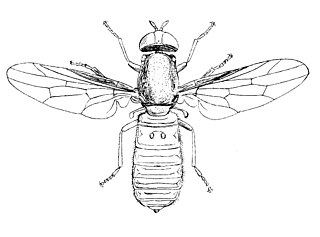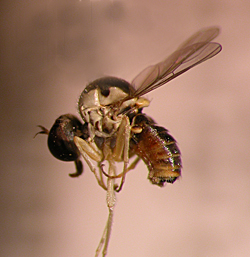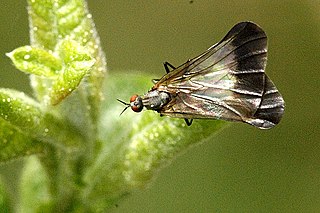
The Empidoidea are a large monophyletic superfamily of true flies, the sister taxon to the Muscomorpha (Cyclorrhapha). These two groups are sometimes united in the unranked taxon Eremoneura. There are some 10,000 known species within Empidoidea, which are represented on all continents except Antarctica. They are known to have existed since the Jurassic period.

Empididae is a family of flies with over 3,000 described species occurring worldwide in all the biogeographic realms but the majority are found in the Holarctic. They are mainly predatory flies like most of their relatives in the Empidoidea, and exhibit a wide range of forms but are generally small to medium-sized, non-metallic and rather bristly.

The Scenopinidae or window flies are a small family of flies (Diptera), distributed worldwide. In buildings, they are often taken at windows, hence the common name window flies.

Hybotidae, the typical dance flies, are a family of true flies. They belong to the superfamily Empidoidea and were formerly included in the Empididae as a subfamily.

Mythicomyiidae, commonly called mythicomyiids, are very tiny flies (0.5–5.0 mm) found throughout most parts of the world, especially desert and semi-desert regions, except the highest altitudes and latitudes. They are not as common in the tropics, but genera such as Cephalodromia and Platypygus are known from these regions. Many of these "microbombyliids" have a humpbacked thorax and lack the dense vestiture common in the Bombyliidae. Mythicomyiids have until recently not had much attention in the literature. Their small size has caused them to be missed when collecting. Yellow pan trapping and fine-mesh netting in Malaise and aerial sweep nets has resulted in a number of undescribed species from many parts of the world. A high diversity of both genera and species exists for this family in Africa, especially northern and southern portions. About 350 species are known. Hundreds more await description.

Dolichocephala is a genus of dagger flies in the family Empididae. There are at least 50 described species in Dolichocephala.

Empis livida is a species of fly in the Empididae family. It is included in the subgenus Kritempis of the genus Empis. Males range from 7.5 to 9.3 millimetres, females 7.5 to 10.2 millimetres. The male's abdomen is brownish and its wings appear faintly brown and clouded. The female's abdomen is gray and its wings are clear. E. livida lives in hedgerows, feeding on the nectar of several species of Rosaceae, several species of Asteraceae, and Heracleum sphondylium nectar; they also feed on other insects. They live all across temperate and Northern Europe, the only species with such a wide distribution. E. livida larvae are also carnivorous and live in damp soil and leaf litter. Adults fly in between April and July.

Empis is a genus of dance fly found in the fly family Empididae.

Hilara is a genus of dance flies, in the fly family Empididae.

Rhamphomyia is a genus of dance flies, in the fly family Empididae. It contains more than 600 species in 8 subgenera.

Hemerodromiinae are a worldwide group of predatory flies in the family Empididae with raptorial forelegs.

Empidinae, also called dance flies, are a subfamily of empidoid flies. They are mainly predatory flies like most of their relatives, and generally small to medium-sized. Most species are flower visitors and they can be effective pollinators.

Phyllodromia is a genus of dance flies. There are about 10 described species in Phyllodromia.

Ragadidae is a family of true flies in the superfamily Empidoidea. It was formerly considered a lower taxon, but was published as a new subfamily within Empididae in 2016. Since then, it has been classified as the sister group to Empididae, and has been elevated to family level based on the genetic differences which separate it from Empididae.

Heleodromia is a genus of flies in the family Empididae.
Wiedemannia is a genus of flies in the family Empididae.
Macrostomus is a genus of flies in the family Empididae.
Porphyrochroa is a genus of flies in the family Empididae.
Chelifera is a genus of flies in the family Empididae.
Homalocnemis is a genus of flies which is placed in a family of its own, the Homalocnemidae. There are about seven species in the genus found in the Afrotropical, Neotropical, and Australasian regions, suggestive of a Gondwanan origin. The genus was formerly considered a primitive empidoid and placed variously in the Hybotidae or in the empidid subfamily Brachystomatinae. They are recognized by their wing venation which includes a long anal cell and a long basal segment of the antennal style.











